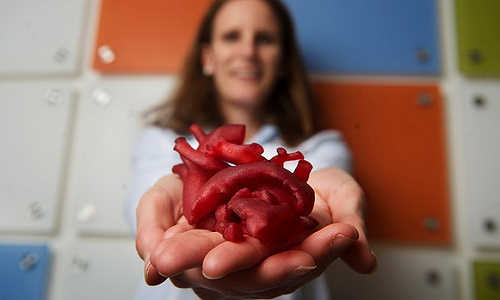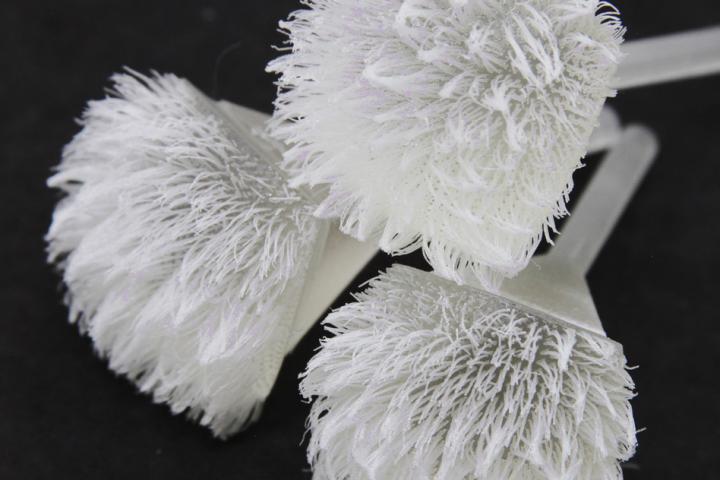New 3D printed heart technology could reduce the number of heart surgeries in children with congenital heart disease, according to Dr Peter Verschueren who spoke on the topic today at EuroEcho-Imaging 2014.1 Dr Verschueren brought 3D printed models of the heart to his lecture including models used to plan real cases in patients.
EuroEcho-Imaging is the annual meeting of the European Association of Cardiovascular Imaging (EACVI), a branch of the European Society of Cardiology (ESC), and is held 3-6 December in Vienna, Austria.
Dr Verschueren said: “Children with congenital heart disease often need up to four open heart surgeries at different times of life. The 3D printed copy of the heart could reduce this to one or two because doctors can choose and practice the best interventional approach and device beforehand. This will avoid children spending months in intensive care.”
Three dimensional (3D) printing uses a machine to print objects layer by layer. Instead of ink the printer uses plastics, metals and other materials. The technology was first used in the automotive and aerospace industries to make prototypes. Dr Verschueren said: “You can make complex, unique things, which is useful in medicine because each patient is different.”
3D printing entered the medical field around two decades ago in craniomaxillofacial and orthopaedic surgery. 3D reconstructions of a patient’s bone were made from a computed tomography (CT) scan. Today the technology is also used to make hearing aids. Printing 3D hearts was made possible with flexible materials for printing and fast scanners that can trace the beating heart. A CT or magnetic resonance imaging (MRI) scan is used to print muscles and valves which can be beating or static.
The models are used to plan surgeries in children with congenital heart diseases such as double outlet right ventricle or Tetralogy of Fallot. Dr Verschueren said: “Until recently, doctors would look at an image and then try to visualise the heart in 3D. Now they can use a 3D copy of an individual patient’s heart to plan the procedure in detail before they go into the operating theatre.”
He added: “This is still a relatively new technology but there is increasing interest in using 3D printed models to plan heart valve interventions in adults. This could include complex bicuspid aortic valve cases that doctors want to treat with transcatheter aortic valve implantation (TAVI) and new transcatheter interventions for repairing or replacing the mitral and tricuspid valves.”
Today at EuroEcho-Imaging, biomedical research engineer Helen O’ Grady from Galway, Ireland, presents a novel 3D printed model of tricuspid regurgitation she developed to test a new device and train interventionists in the implantation procedure.2 Ms O’Grady used CT scans of tricuspid regurgitation patients to build a 3D software model which she then used for 3D printing of a right heart and tricuspid valve annulus model..
She took the additional step of using the 3D printed model to mould a more flexible model that is compatible with echocardiography and fluoroscopy. It is housed in a cardiac anatomy rig that replicates the anatomical conditions of the heart in the body as well as the leaflet motion of the valve. Doctors can use the model to practice implantation of the device on a patient’s exact anatomy before the procedure.
Ms O’Grady, said: “There is a variation in normal anatomies and more so in diseased anatomies such as tricuspid regurgitation. Being able to practice on the model allows for better surgical planning and doctors can optimise the interventional procedure pre-operatively. Cardiologists, surgeons and physicians say there’s nothing like having a tangible model in your hands as it gives such invaluable insight into the patient anatomy involved.”
She added: “3D models can be used to discuss the intervention with the medical team, patients and, in the case of congenital heart defects, with parents. It helps everyone affected to better understand what the procedure will involve.”
Professor Patrizio Lancellotti, EACVI President, said: “3D imaging is a main theme of EuroEcho-Imaging this year and 3D printing of the heart is particularly exciting. It allows us to make a perfect model of a patient’s anatomy and decide the optimal device and procedure in advance.”
Story Source:
The above story is based on materials provided by European Society of Cardiology.




